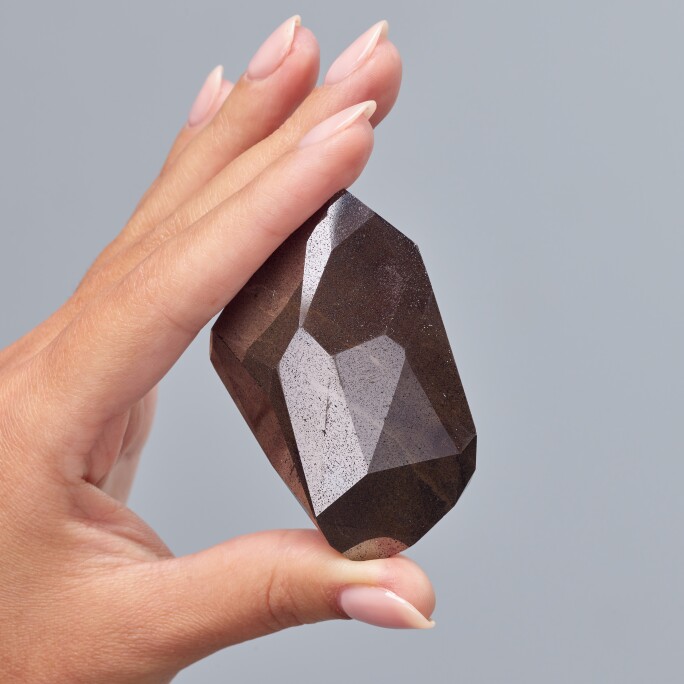Sometimes a diamond comes along that stands out even from the most historic gems. The Enigma, which is selling online from London between 3rd to 9th February, is absolutely one of them.
A fancy, natural-colour, black diamond with 55 facets, weighing 555.55 carats, its existence is a feat of craftsmanship, fate, vision – and probably a fair bit of luck too. But how did it all come together?
Well, let’s start with the size. At 555.55 carats, it is listed as the largest faceted diamond in the world in the Guinness Book of World Records, while GIA and Gubelin reports confirm it as being the largest fancy black natural colour black diamond ever recorded.
'GIA and Gubelin reports confirm it as being the largest fancy black natural colour black diamond ever recorded'
But while vast rough diamonds do turn up from time to time, it is extremely unusual for them to be kept as one stone rather than being broken up. Even the famous 3,106.75-carat Cullinan was cleaved into nine major stones (including the 530.2 carat Cullinan I embedded within the British Royal sceptre), as well as many smaller ones.

It took a rare vision to keep it in one piece – and remarkable skill to cut it at precisely 555.55 carats, while also creating 55 facets, which adds to the stone a symbolic significance in Middle Eastern cultures, where the number five has special significance.
“The stakes would have been very high,” says Chris O’Farrell, the diamond expert at Hatton Garden’s Daniel Christopher, and one of the UK’s top diamantaires. O’Farrell, who has been cutting diamonds in Hatton Garden since the 1960s and has assessed some of the world’s most prestigious diamonds, is under no illusions about the difficult task faced by the Enigma’s cutters.

“I bet whoever cut it still had a very nervous few months sitting at his bench,” he says. “They’d have had to make a specialist dop [the stick that secures the diamond for cutting]. And a black diamond like this is very, very hard – the blackness in them is made of a mass of small pinpoints that give the colour, each one is like a diamond inside a diamond. Cutting against the grain, with all those facets on different angles? It’s almost impossible.”
In fact, a natural black carbonado is one of the hardest materials known to man, thanks to that structure, and would have taken a considerable time to cut – which explains the several years between the Enigma's acquisition by its current owner, two decades ago, and its certification by the GIA as a faceted diamond in 2004.

“Years ago, one of my colleagues cut a 106-carat briolette cognac diamond, and that took about five months, so this one could have been years,” says O’Farrell. “Just polishing one of those big facets on the Enigma could take days of solid work. And getting it to just that precise 555.55 carats, no more or less, on 55 facets – that would be difficult.”
O’Farrell speaks with the understatement of a craftsman, but to Nikita Binani, Sotheby’s Head of Sales for Special Jewellery, the Enigma is more than a technical feat – it’s a creative one too.
“It’s really an object of art,” she says. “You hold it in your hand and it really does resonate, it really does speak. It’s a once-in-a-lifetime piece. Something like this is partly planned and partly a bit of destiny.”

Significant credit must also go to the owner, whose plan for this stone was to cut it not only with the number five (hamsa in Arabic) riven through its weight and facets, but also to echo the hand-shaped Hamsa amulet (also known as the Hand of Fatima), worn and carried across the Middle East as a sign of strength, luck and protection against evil.
Thus the design is unlike any of the traditional diamond cuts, which nowadays tend to have 57 or 58 facets. Instead, it is an abstraction of a hand, tapering in silhouette as if from palm to fingers. It is extraordinary – and a brave decision when it is notoriously so hard to predict exactly how the internal structure of a large diamond will fall.
“I think you always have a vision for something of that size and that grandeur,” says Binani. “The real question is: can you really get there? From a rough to polish, doesn’t always evolve as planned. You can’t always control it. So as well as a piece of art, it is truly a natural phenomenon. Almost a destiny.”
The carbonado is also an extraterrestrial phenomenon, experts believe. Unlike most diamonds, which are largely surfaced through Kimberlite magma from a depth of up to 250km in the Earth’s mantle, carbonados are believed to have originated deep in outer space.

They are only found in Brazil and the Central African Republic, and are believed to have been created either by meteoric impacts producing vapour deposits, or from supernovae explosions that formed diamond-bearing asteroids that collided with Earth. This widely-held theory is supported by the presence of elements and minerals abundant in space – including osbornite, a mineral uniquely found in meteors – as well as the fact that these diamonds are found on or close to the Earth’s surface, rather than buried deep.

Of course, the carbonado may be nearly four billion years old, but black diamonds have never been more fashionable or valuable. Once, due to their hardness, relegated to industrial uses, they have been radically reappraised over the last few years, and are now often used in preference to fancy-coloured diamonds for their mystery and dark, avant-garde polish.
And while it is unlikely that the Enigma will be used in a piece of jewellery, its lustre is, says Binani, spectacular – the lustre of a true diamond. A diamond from the sky.

